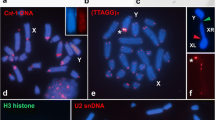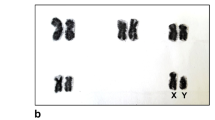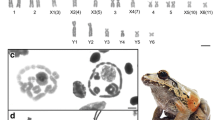Summary
-
1.
Species of the genus Compsothespis have an X1X2Y trivalent in the male with both ends of the X2 chromosome associated with the same end of the Y. This X1X2Y mechanism must have had an independent origin from the one found in the Mantinae sensu stricto.
-
2.
A second species of Rhodomantis has been shown to have an X1X2Y trivalent in which X1 and X2 are associated with the same limb of the Y, leaving the other limb free. The sex chromosome mechanisms of Compsothespis and Rhodomantis both imply the existence of triple synaptic segments.
-
3.
The genera Bolbe, Ligaria, Hoplocorypha, Antistia, Dystacta, Bisanthe and Harpagomantis have XO males.
-
4.
A species of Dystacta is polymorphic for a pericentric inversion. A species of Hoplocorypha and one of Antista are polymorphic for fusions or dissociations.
-
5.
The genera Sphodropoda, Polyspilota and Archimantis belong to the group of X1X2Y Mantinae sensu stricto. It has been shown that those members of this group which have very small Y-chromosomes have the pairing limbs of the X1 and X2 chromosomes unusually long; it is probable that this situation is due to translocations having occurred whereby material was transferred from the Y to the X's.
-
6.
Bolbe and Harpagomantis are added to the list of mantid genera with achiasmatic meiosis (Callimantis-type) in the male. Achiasmatic meiosis has probably been evolved at least five times in the phylogeny of the mantids.
-
7.
Some comparisons are made between the achiasmatic mechanisms which have evolved in certain mantid genera and in a few species of Thericleine Eumastacid grasshoppers.
Similar content being viewed by others
References
Andrewartha, H. G., and L. C. Birch: The Distribution and Abundance of Animals. Chicago: Chicago University Press 1954.
Beier, M.: Mantodea, Fam. Mantidae; Subfam. Hymenopodinae. Genera Insectorum fasc. 196, 36 p. Brussels: Wytsman 1934;- Mantodea, Fam. Mantidae; subfam. Thespinae. Genera Insectorum fasc. 200, 32 p. Brussels: Wytsman 1937a; - Mantodea. Fam. Mantidae; subfam. Mantinae. Genera Insectorum fasc. 203, 143 p. Brussels: Wytsman 1937b.
Callan, H. G., and P. A. Jacobs: The meiotic process in Mantis religiosa L. males. J. Genet. 55, 200–216 (1957).
Darlington, C. D.: Meiosis in polyploids. II. J. Genet. 21, 17–56 (1929).
Dutt, M. K.: On the chromosome morphology of Humbertiella indica Saussure (Eremiaphilinae, Mantidae). Caryologia (Firenze) 6, 117–123 (1954).
Giglio-Tos, E.: Mantidae. Das Tierreich, vol. 50. Berlin und Leipzig: W. de Gruyter & Co. 1927.
Hughes-Schrader, S.: Meiosis without chiasmata in diploid and tetraploid spermatocytes of the mantid Callimantis antillarum Saussure. J. Morph. 73, 111–141 (1943a); - Polarization, kinetochore movements and bivalent structure in the meiosis of male mantids. Biol. Bull. 85, 265–300 (1943b); - The chromosomes of mantids (Orthoptera:Manteidae) in relation to taxonomy. Chromosoma (Berl.) 4, 1–55 (1950); - The nuclear content of desoxyribonucleic acid and interspecific relations in the mantid genus Liturgousa (Orthoptera:Mantoidea). Chromosoma (Berl.) 5, 544–554 (1953); - Supplementary notes on the cyto-taxonomy of mantids (Orthoptera:Mantoidea). Chromosoma (Berl.) 6, 79–90 (1953a); - The DNA content of the nucleus as a tool in the cytotaxonomic study of insects. Proc. X. Internat. Congr. Entomol. Montreal 2, 935–944 (1958).
John, B., and K. R. Lewis: Nucleolar controlled segregation of the sex chromosomes in beetles. Heredity 15, 431–439 (1960).
Mesa, A.: Mecanismo cromosómico de determinación sexual poco frecuente en Scotussa daguerrei Lieb. (Orthoptera-Acrididae). Rev. Soc. Entomol. argent. 26, 119–124 (1963).
Newton, W. C. F., and C. D. Darlington: Meiosis in polyploids. I. J. Genet. 21, 1–16 (1929).
Oguma, K.: Karyotype and phylogeny of the mantids. La Kromosomo, 1, 1–5 (1946).
Wahrman, J.: Evolutionary changes in the chromosome complement of the Amelinae (Orthoptera:Mantodea). Experientia (Basel) 10, 176–177 (1954a); - Cytological polymorphism and chromosomal evolution in mantids. Proc. IX. Internat. Genet. Congr. Bellagio p. 683–684 (1954b).
—, and R. O'brien: Nuclear content of DNA in chromosomal polymorphism in the genus Ameles (Orthoptera: Mantoidea). J. Morph. 99, 259–270 (1956).
White, M. J. D.: A new and anomalous type of meiosis in a mantid, Callimantis antillarum Saussure. Proc. roy. Soc. B 125, 516–523 (1938); - The origin and evolution of multiple sex chromosome mechanisms. J. Genet. 40, 303–336 (1940); - The evolution of the sex chromosomes. I. The XO and X1X2Y mechanisms in praying mantids. J. Genet. 42, 143–172 (1941); - Telomeres and terminal chiasmata — a reinterpretation. Biological Contributions, Univ. Texas Publ. 5914, 107–111 (1959); - A unique type of sex chromosome mechanism in an Australian mantid. Evolution (Lawrence, Kansas) 16, 75–85 (1962); - Chiasmatic and achiasmatic meiosis in African eumastacid grasshoppers. Chromosoma (Berl.) 16, 271–307 (1965).
Author information
Authors and Affiliations
Additional information
Dedicated to my friend Professor Sajiro Makino, with respect and admiration, on the occasion of his sixtieth birthday.
Supported in part by Public Health Service Grant GM 07212-04 from the Division of General Medical Sciences, U.S. National Institutes of Health.
Rights and permissions
About this article
Cite this article
White, M.J.D. Sex chromosomes and meiotic mechanisms in some African and Australian Mantids. Chromosoma 16, 521–547 (1965). https://doi.org/10.1007/BF00326972
Received:
Issue Date:
DOI: https://doi.org/10.1007/BF00326972




